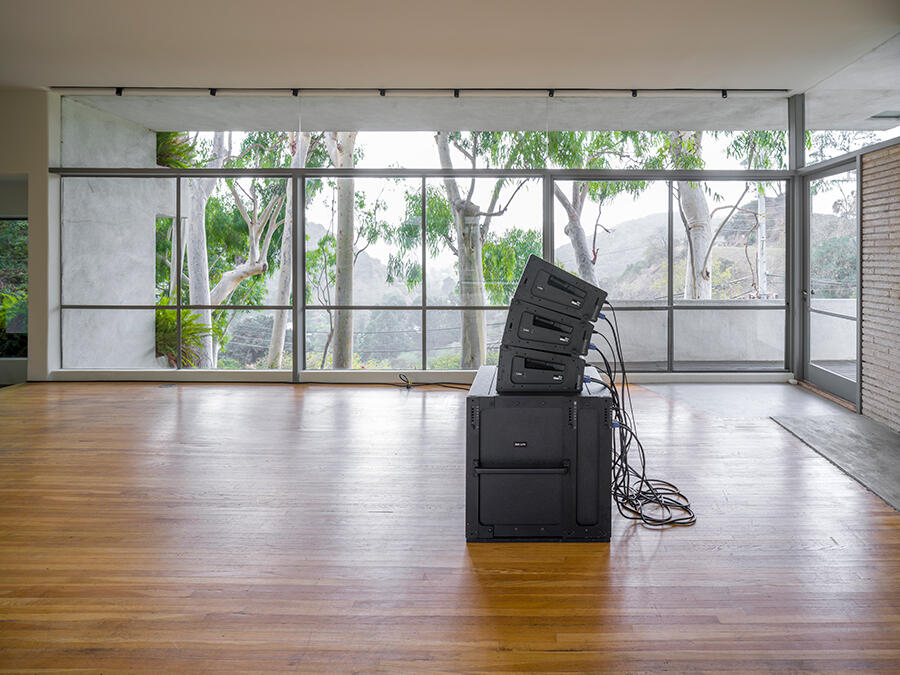Florian Hecker’s Wall of Sound
For his first solo show in Los Angeles, the artist transforms Rudolf Schindler’s famed Fitzpatrick-Leland House into a large-scale sonic installation
For his first solo show in Los Angeles, the artist transforms Rudolf Schindler’s famed Fitzpatrick-Leland House into a large-scale sonic installation

Sound has the ability to mark borders and claim territories: radiating from its point of emission, sound fills the air with both audible and spatial volume. Knowing this, we build spaces to house our sounds: environments for optimal listening. The Fitzpatrick-Leland House in Los Angeles, which serves as the venue for Florian Hecker’s exhibition ‘Resynthesizers’, would probably not deserve this description. Nevertheless, Rudolf Schindler’s famous theoretical reduction of architecture, as realized in this building that overlooks the neighbourhood of Laurel Canyon from high up on Mulholland Drive, resonated – if not sympathetically, then intriguingly – with the sound forms that Hecker introduced into it.

In a 1918 manifesto – later published in the essay ‘Space Architecture’ (1934) – Schindler railed against architects who ‘gather and pile up masses of material and leave empty hollows for human use’. Pejoratively likening this kind of intensive building process to sculpture, he instead proposed building outward from space. Hecker’s work in sound would seem to hinge on a related polemic. If what the artist makes can be described as sound-sculpture, then it is certainly an extreme interpretation: this is the extension of sound into a form without shaping contours. It builds on itself, regenerating from out of its elementary particles, in a kind of algorithmic autopoiesis.

For ‘Resynthesizers’, Hecker devised three short compositions, ranging from three to five minutes in length (incidentally, the running time of most pop songs), which were fed into a super-computer at the University of Edinburgh, which then output variations in the style of the models, and then more variations on those variations plus the models, which are periodically returned to as if in a self-testing of the program’s aesthetic validity. The sound thus grows impossibly congested, but then also reduces, as sections that no longer suit the greater progression are systematically pared away. Three re-synthesized compositions were produced in this way and played back from elaborate speaker systems installed on each floor of Schindler’s split-level dwelling. Shuttled back and forth, these were calculated to cover the four-month timeframe of the exhibition, so that no visitor could ever experience the same thing twice.

On the day of my visit, it so happened that the ground level was filled with languorously low-end, bass-heavy tones that grew progressively higher as I ascended the stairs. At the top level, I was assailed by a chirpy buzzing, as though stepping into a hellish, electronic beehive. The hyper-complexity of Hecker’s sound designs can invoke feelings of panic in listeners, as we are made acutely aware of our lag in processing power and impending obsolescence. Glancing out of the window, I saw a man wearing only a toga sitting still beneath a tree and asked the show’s organizers – Matt Connolly and Ellie Lee from the non-profit arts organization Equitable Vitrines – if he had been planted there by the artist. They replied in the negative, adding that he was probably tripping on acid. This figure had appeared before us as a readymade parody of the Edenic redemption once promised by Schindler’s open-plan modernity. I also thought about all the hippie singer-songwriters that settled in these parts some years after the architect’s death – their cozy music so antithetical to Hecker’s digital onslaught. The rush of noise in ‘Resynthesizers’ is almost unbearable, but what if we were to surrender to it? Perhaps we could hear in it a distant echo, a child, always in the next room, practicing scales on their home piano.
Florian Hecker’s ‘Resynthesizers’ is on view at Fitzpatrick-Leland House, MAK Center for Art and Architecture, Los Angeles, USA, until 13 March. To make an appointment visit the Equitable Vitrines website.
Main image: Florian Hecker, ‘Resynthesizers’, 2021, installation view. Courtesy: © Equitable Vitrines; photograph: Fredrik Nilsen Studio






















